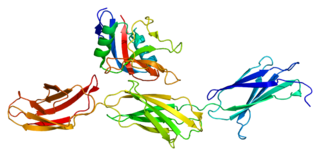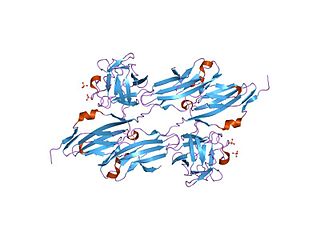| CNTN1 | |||||||||||||||||||||||||||||||||||||||||||||||||||
|---|---|---|---|---|---|---|---|---|---|---|---|---|---|---|---|---|---|---|---|---|---|---|---|---|---|---|---|---|---|---|---|---|---|---|---|---|---|---|---|---|---|---|---|---|---|---|---|---|---|---|---|
| |||||||||||||||||||||||||||||||||||||||||||||||||||
| Identifiers | |||||||||||||||||||||||||||||||||||||||||||||||||||
| Aliases | CNTN1 , F3, GP135, MYPCN, contactin 1 | ||||||||||||||||||||||||||||||||||||||||||||||||||
| External IDs | OMIM: 600016 MGI: 105980 HomoloGene: 7274 GeneCards: CNTN1 | ||||||||||||||||||||||||||||||||||||||||||||||||||
| |||||||||||||||||||||||||||||||||||||||||||||||||||
| |||||||||||||||||||||||||||||||||||||||||||||||||||
| |||||||||||||||||||||||||||||||||||||||||||||||||||
| |||||||||||||||||||||||||||||||||||||||||||||||||||
| Wikidata | |||||||||||||||||||||||||||||||||||||||||||||||||||
| |||||||||||||||||||||||||||||||||||||||||||||||||||
Contactin 1, also known as CNTN1, is a protein which in humans is encoded by the CNTN1 gene. [5] [6]
| CNTN1 | |||||||||||||||||||||||||||||||||||||||||||||||||||
|---|---|---|---|---|---|---|---|---|---|---|---|---|---|---|---|---|---|---|---|---|---|---|---|---|---|---|---|---|---|---|---|---|---|---|---|---|---|---|---|---|---|---|---|---|---|---|---|---|---|---|---|
| |||||||||||||||||||||||||||||||||||||||||||||||||||
| Identifiers | |||||||||||||||||||||||||||||||||||||||||||||||||||
| Aliases | CNTN1 , F3, GP135, MYPCN, contactin 1 | ||||||||||||||||||||||||||||||||||||||||||||||||||
| External IDs | OMIM: 600016 MGI: 105980 HomoloGene: 7274 GeneCards: CNTN1 | ||||||||||||||||||||||||||||||||||||||||||||||||||
| |||||||||||||||||||||||||||||||||||||||||||||||||||
| |||||||||||||||||||||||||||||||||||||||||||||||||||
| |||||||||||||||||||||||||||||||||||||||||||||||||||
| |||||||||||||||||||||||||||||||||||||||||||||||||||
| Wikidata | |||||||||||||||||||||||||||||||||||||||||||||||||||
| |||||||||||||||||||||||||||||||||||||||||||||||||||
Contactin 1, also known as CNTN1, is a protein which in humans is encoded by the CNTN1 gene. [5] [6]
The protein encoded by this gene is a member of the immunoglobulin superfamily. It is a glycosylphosphatidylinositol (GPI)-anchored neuronal membrane protein that functions as a cell adhesion molecule. It may play a role in the formation of axon connections in the developing nervous system. Two alternatively spliced transcript variants encoding different isoforms have been described for this gene. [6]

L1, also known as L1CAM, is a transmembrane protein member of the L1 protein family, encoded by the L1CAM gene. This protein, of 200-220 kDa, is a neuronal cell adhesion molecule with a strong implication in cell migration, adhesion, neurite outgrowth, myelination and neuronal differentiation. It also plays a key role in treatment-resistant cancers due to its function. It was first identified in 1984 by M. Schachner who found the protein in post-mitotic mice neurons.

Protein tyrosine phosphatases (EC 3.1.3.48, systematic name protein-tyrosine-phosphate phosphohydrolase) are a group of enzymes that remove phosphate groups from phosphorylated tyrosine residues on proteins:

Protein tyrosine kinase 2 beta is an enzyme that in humans is encoded by the PTK2B gene.

Receptor-type tyrosine-protein phosphatase alpha is an enzyme that in humans is encoded by the PTPRA gene.

Receptor-type tyrosine-protein phosphatase F is an enzyme that in humans is encoded by the PTPRF gene.

Receptor-type tyrosine-protein phosphatase zeta also known as phosphacan is an enzyme that in humans is encoded by the PTPRZ1 gene.

Contactin-2 is a protein that in humans is encoded by the CNTN2 gene.

Neurofascin is a protein that in humans is encoded by the NFASC gene.

Receptor-type tyrosine-protein phosphatase mu is an enzyme that in humans is encoded by the PTPRM gene.

Neuronal cell adhesion molecule is a protein that in humans is encoded by the NRCAM gene.

Receptor-type tyrosine-protein phosphatase PCP-2, is an enzyme that in humans is encoded by the PTPRU gene.

Neurocan core protein is a protein that in humans is encoded by the NCAN gene.

Receptor-type tyrosine-protein phosphatase kappa is an enzyme that in humans is encoded by the PTPRK gene. PTPRK is also known as PTPkappa and PTPκ.

Receptor-type tyrosine-protein phosphatase T is an enzyme that in humans is encoded by the PTPRT gene.

Contactin-4 is a protein that in humans is encoded by the CNTN4 gene.

Tyrosine-protein phosphatase non-receptor type 14 is an enzyme that in humans is encoded by the PTPN14 gene.

Tenascin-R is a protein that in humans is encoded by the TNR gene.

I-set domains are found in several cell adhesion molecules, including vascular (VCAM), intercellular (ICAM), neural (NCAM) and mucosal addressin (MADCAM) cell adhesion molecules, as well as junction adhesion molecules (JAM). I-set domains are also present in several other diverse protein families, including several tyrosine-protein kinase receptors, the hemolymph protein hemolin, the muscle proteins titin, telokin, and twitchin, the neuronal adhesion molecule axonin-1, and the signalling molecule semaphorin 4D that is involved in axonal guidance, immune function and angiogenesis.

Contactin 6 is a protein in humans that is encoded by the CNTN6 gene.

CASPR also known as Contactin associated protein 1, Paranodin and CASPR1 is a protein that in humans is encoded by the CNTNAP1 gene. CASPR is a part of the neurexin family of proteins, hence its another name "Neurexin IV". CASPR is a membrane protein found in the neuronal membrane in the paranodal section of the axon[[]] in myelinated neurons, between the Nodes of Ranvier containing Na+ channels, and juxtaparanode, which contains K+ channels. During myelination, caspr associates with contactin in a cis complex, though its precise role in myelination is not yet understood.